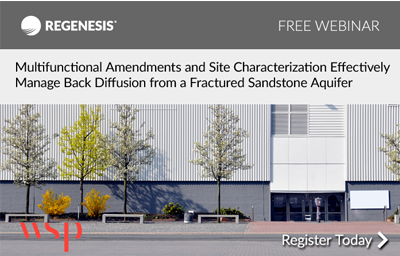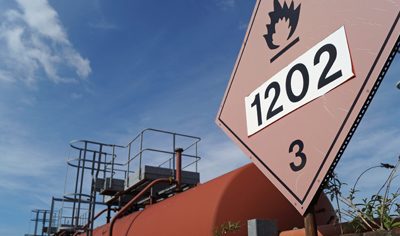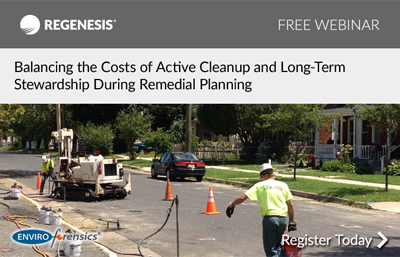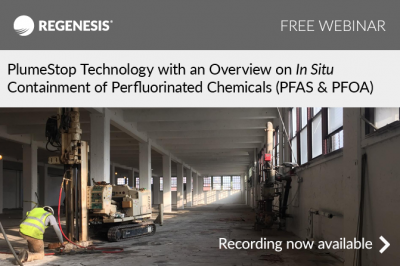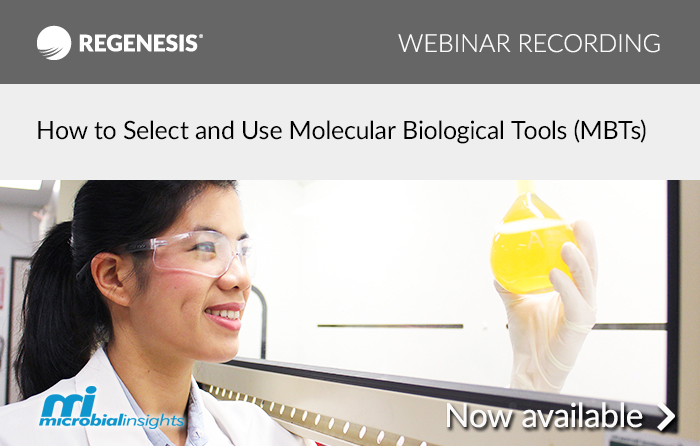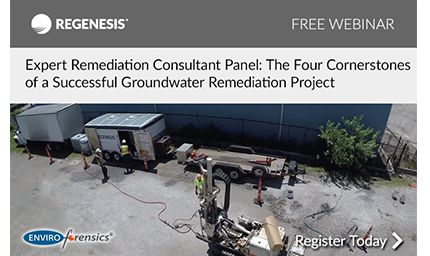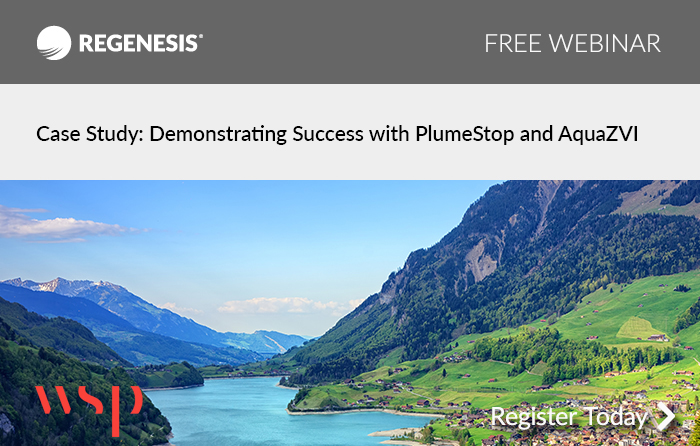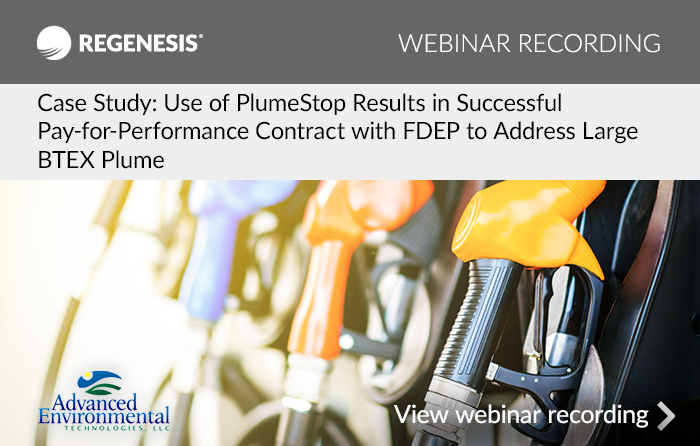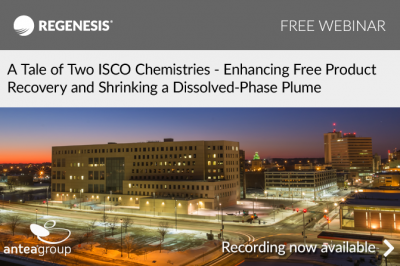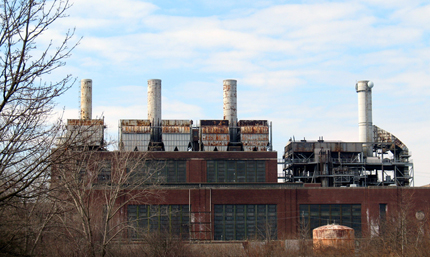Multifunctional Amendments and Site Characterisation Effectively Manage Back Diffusion from a Fractured Sandstone Aquifer
First broadcast: June 27, 2017
Speakers: Matthew Burns, Technical Fellow at WSP
Recording Available| Fractured bedrock aquifers can be extremely heterogeneous which not only results in complex dissolved plume behavior but can also hinder in situ remediation efforts that rely on subsurface injection of amendments to promote microbial activity and abiotic degradation. Simply put, injected amendments may bypass or have limited contact time with impacted zones due to transport differences within primary and secondary rock porosity and other subsurface heterogeneities. With thorough characterization of site hydrology, novel amendment formulations, routine performance monitoring, and an adaptive site management approach however,in situ remediation can be successful in fractured bedrock aquifers.
In this webinar we are pleased to have as a special guest speaker Matthew Burns, Technical Fellow and the in situ remediation Practice Leader for WSP. He presents a case study of a site where multifunctional amendments were applied to manage back diffusion of chlorinated VOCs from a fractured sandstone aquifer. He is joined by Maureen Dooley, Director of Strategic Projects at REGENESIS.
View webinar recording
EU Webinar: From site investigation to sign off – A holistic approach to addressing petroleum hydrocarbon contamination
First broadcast: June 14, 2017
Speakers: Gareth Leonard (Managing Director of REGENESIS Ltd.) and Simon Ware (Managing Director of UK based environmental consultancy WDE)
Using the case study of the redevelopment of a former petrol filling station, Gareth Leonard (Managing Director of Regenesis Ltd) and guest speaker Simon Ware (Managing Director of UK based environmental consultancy, WDE), discuss the process of devising, optimising and delivering the remedial solution for sites impacted with petroleum hydrocarbons. Discussion is made on the importance of integrating the activities of consultant and potential solutions provider. The intention of the presentation is to share experience of the successful investigation, remediation and validation of sites impacted with petroleum hydrocarbons and will be of interest to contaminated land practitioners, regulators and problem holders.
The presentation covers:
- Important site investigation parameters for both understanding the site and allowing the creation of an accurate and efficient remedial design
- Remediation drivers and targets
- The value of early discussions and gap analysis by environmental consultant and solutions provider
- The choice and explanation of different remedial techniques, what they can achieve and how they can be used together to improve treatment efficiency
- Exemplified by the investigation, remediation and closure of a recent site, with other case study references used for illustrative purposes
View webinar recording
Balancing the Costs of Active Cleanup and Long-term Stewardship during Remedial Planning
Recording Available | Long-term Stewardship (LTS) during remedial planning refers to future monitoring and management of the contamination at soil or groundwater remediation sites where cleanup activities will leave behind some measure of residual impacts.
In this free webinar we are pleased to have as a special guest speaker Jeffrey Carnahan, Executive Vice President for EnviroForensics, who will discuss this topic in depth. This presentation features real-world examples of remediation approach evaluations at real sites, as well as Q+As from the live audience. The full recording of the webinar is now available to view online.
View this free webinar
PlumeStop Technology with an Overview on In Situ Containment of Perfluorinated Chemicals (PFAS & PFOA)
First broadcast: February 16, 2017
Speakers: Kristen Thoreson, Ph.D., REGENESIS Research and Development Manager
Recording Available | In this webinar we’re pleased to have Dr. Kristen Thoreson, REGENESIS Research and Development Manager and lead inventor of PlumeStop Liquid Activated Carbon.
Her presentation focuses on PlumeStop and the technology’s ability to treat perfluorinated chemicals, including PFAS and PFOA. The full recording of the presentation is now available to view online.
View webinar recording
How to Select and Use Molecular Biological Tools (MBTs)
First broadcast: July 18, 2018
Speakers: Dora Taggart President, Microbial Insights, Inc.
In this webinar we are pleased to have as a special guest speaker Dora Taggart, President of Microbial Insights, Inc. (MI). Her presentation will include a series of case studies that demonstrate how molecular biological tools (MBTs) such as QuantArray® and compound specific isotope analysis (CSIA) provided actionable data that directly impacted site management decisions.
View the recording of this free webinar
Expert Remediation Consultant Panel: The Four Cornerstones of a Successful Groundwater Remediation Project
First broadcast: June 26, 2018
Speakers: Jeff Carnahan, President, EnviroForensics & PolicyFind and Keith Gaskill, Chief Geologist, EnviroForensics will join Barry Poling and Doug Davis of REGENESIS
In this webinar we are pleased to have a panel of remediation experts who each bring unique expertise, background and skill sets to a discussion on remediation best practices. Jeffrey Carnahan and Keith Gaskill of EnviroForensics® join Barry Poling and Doug Davis of REGENESIS® for a presentation on the cornerstones of a successful groundwater remediation project. The four essential cornerstones to building a successful groundwater remediation approach are:
- Dynamics
- Diversity
- Certainty
- Affordability
In some less complex scenarios, one or more of these cornerstones may play a lesser role than the others. But, when dealing with more complicated sites, like those with chlorinated solvents or complex geological conditions, each cornerstone demands equal attention to ensure the completion of project objectives. During this webinar presentation, we explain how Dynamics, Diversity, Certainty and Affordability can individually, and jointly, impact the overall project success. Real world examples are used to highlight important points, and to demonstrate how EnviroForensics and REGENESIS managed a high-profile remediation project at a chlorinated solvent release by having all four cornerstones firmly in place.
View the recording of this free webinar
Case study: Demonstrating success with PlumeStop and colloidal ZVI – with Matt Burns of WSP
First broadcast: May 30, 2018
Speakers: Matthew Burns, Technical Fellow WSP
Recording Available| We are pleased to have guest speaker Matt Burns, Senior Fellow at WSP present this live, international webinar. He will present PlumeStop® and colloidal ZVI (cZVI) treatment case studies and practical analytical strategies used to demonstrate destructive treatment.
Stimulating biodegradation of chlorinated VOCs on activated carbon and direct abiotic treatment of using reduced metals such as ZVI are not new to the remediation industry and have proven to be highly effective when direct contact is made. However, the colloidal solid composition of these materials severely limits efficient in situ application at most sites.
The steric stabilization chemistry behind the Regenesis products PlumeStop and cZVI eases delivery challenges and dramatically widens the applicability window of these amendments to include most sites where in situ remediation is contemplated. These transformational amendments bring a unique set of regulatory and performance monitoring challenges when discerning desirable destructive processes from often unacceptable non-destructive mechanisms.
About the Presenter:
Matthew Burns, Technical Fellow | U.S. Contaminated Land National Service Line Director, WSP
Matt is a Technical Fellow and the U.S. contaminated land national service line director for WSP with more than 25 years of professional chemistry and engineering experience. He is based in Boston, Massachusetts and is responsible for the financial and technical depth and breadth of the contaminated land (site investigation and remediation) service line. Matt brings chemical and microbial process expertise to assist local WSP teams with challenging investigation and remediation projects in the U.S. and across the globe.
Complete the form below to view the free recording of this webinar.
View webinar recording
.
Case Study: Use of PlumeStop Results in Successful Pay-for-Performance Contract with FDEP to Address Large BTEX Plume
First broadcast: April 26, 2018
Speakers: Gordon Dean, Vice President of Advanced Environmental Technologies (AET)
In this webinar we are pleased to have as a special guest speaker Gordon Dean, Vice President of Advanced Environmental Technologies, LLC (AET). His presentation discusses a project where Mr. Dean designed a remedial approach employing PlumeStop®, RegenOx® and ORC Advanced® to sorb, degrade and destroy an existing petroleum contaminant plume. Because Mr. Dean’s remediation solution leveraged a combined remedy featuring PlumeStop, the project was awarded a pay-for-performance contract with the Florida Department of Environmental Protection (FDEP).
View the recording of this free webinar
Jack Sheldon: A Tale of Two ISCO Chemistries
First broadcast: January 31, 2017
Speakers: Jack Sheldon, Senior Remediation Specialist at Antea Group
Recording Available | In this webinar we’re pleased to have Mr. Jack Sheldon, nationally recognized remediation expert and Senior Remediation Specialist at Antea Group®. Mr. Sheldon’s expertise spans over 34 years of remediation experience and sites in all 50 states and around the world.
His presentation focuses on a case study of a petroleum hydrocarbon impacted site where a sequence of in situ remediation technologies from REGENESIS were applied to address multiple phases of the contamination. The project remediation process, from planning to full implementation, are discussed.
View webinar recording
Biodegradazione dei contaminanti in falda utilizzando PlumeStop Liquid Activated Carbon
First broadcast: 01.12.2016
Speakers: Ing. Marcello Carboni e l’Ing. Paola Goria (REGENESIS)
Si prega di compilare il modulo sottostante per accedere alla registrazione del webinar sul PlumeStop.
Il prodotto PlumeStop è un innovativo trattamento in situ per acque di falda che è stato introdotto sul mercato nel 2014 e da allora è stato applicato in più di 80 siti nel mondo tra cui USA, Italia, Belgio, Regno Unito e Svezia. In questo webinar l’Ing. Marcello Carboni e l’Ing. Paola Goria descriveranno nel dettaglio le performance del PlumeStop osservate in campo.

 Americas
Americas Europe
Europe Français
Français Deutsch
Deutsch Italiano
Italiano Español
Español